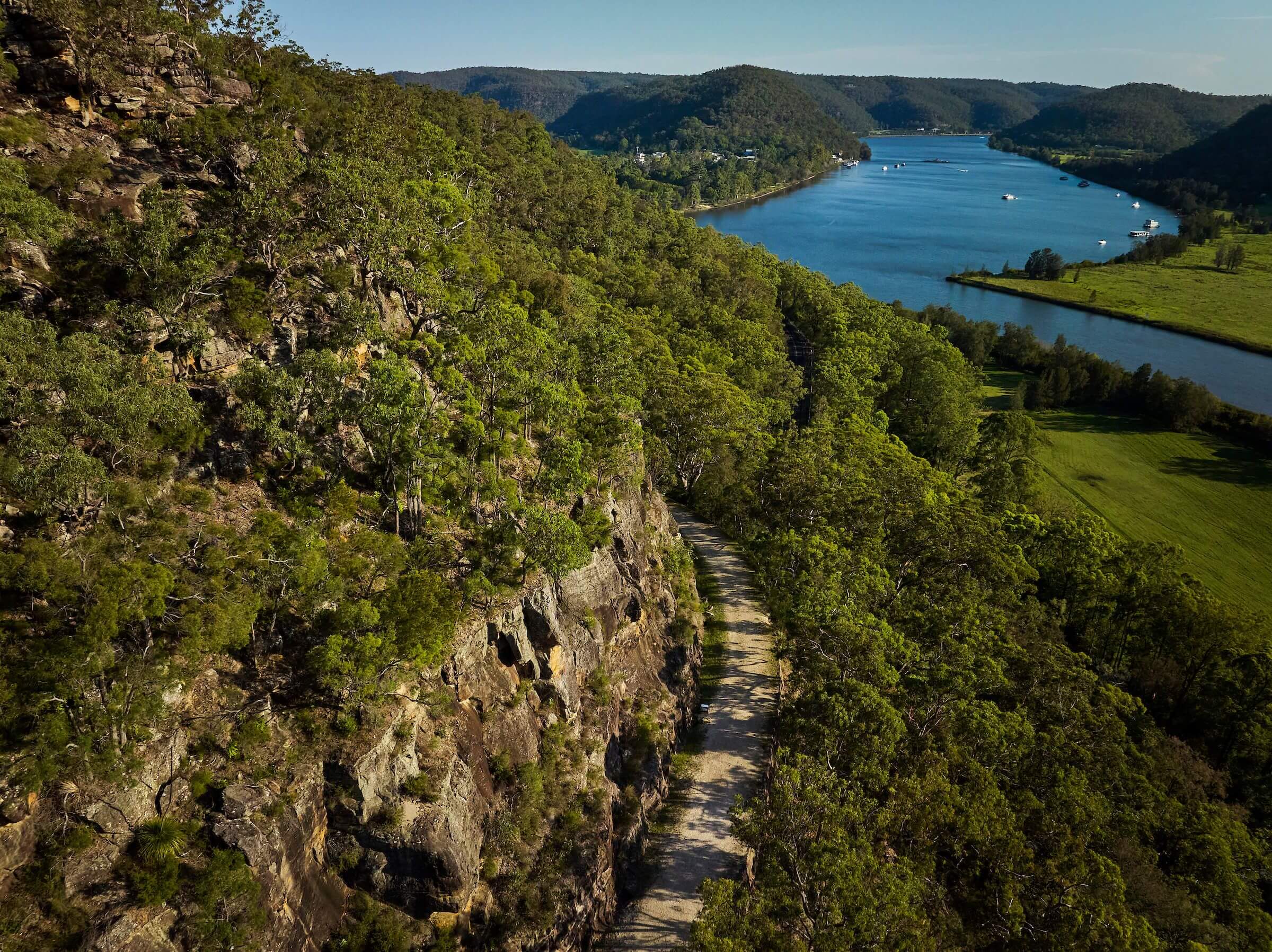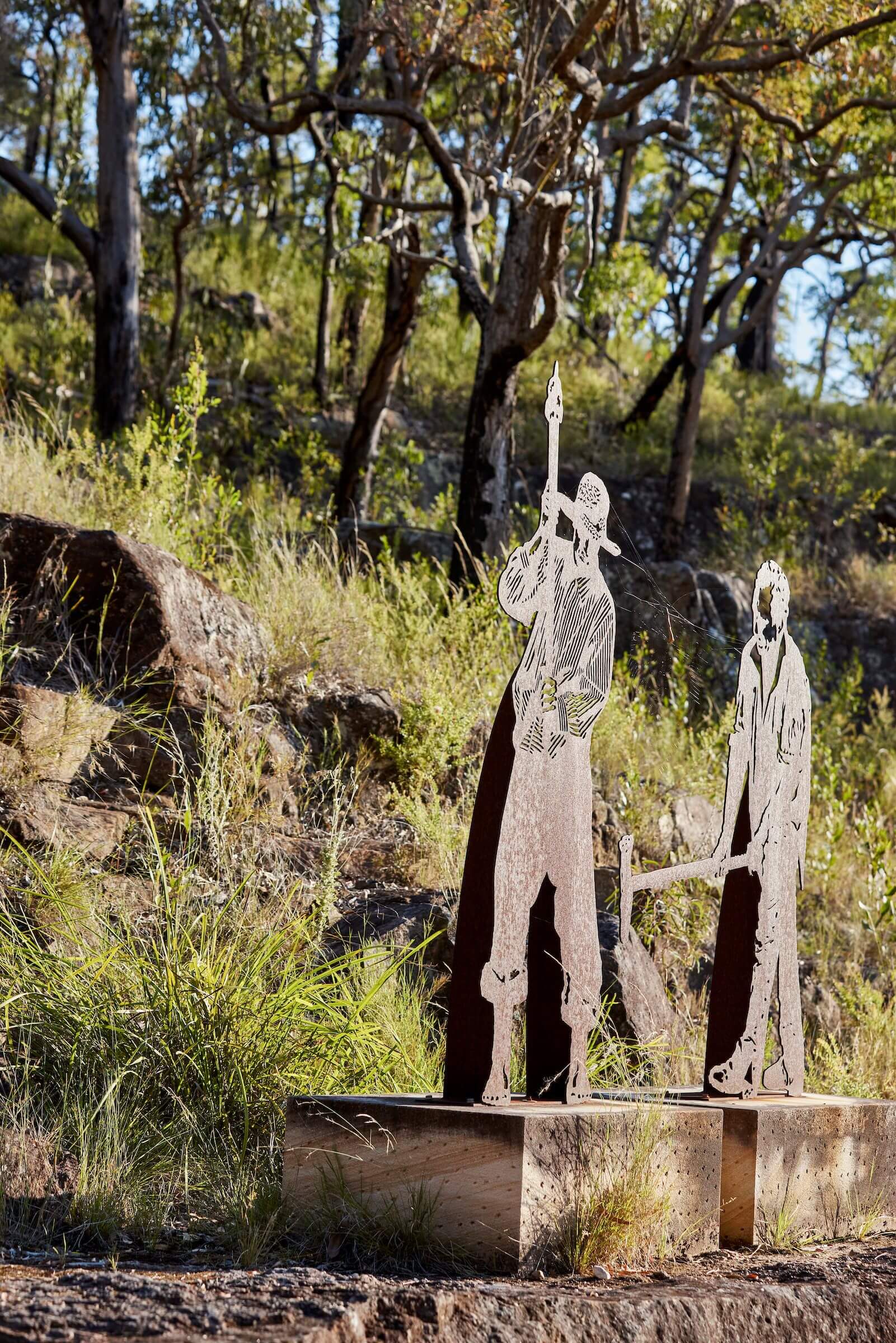
Visitor's guide to the World Heritage listed Old Great North Road
Step back in time on the Old Great North Road
Hidden deep inland from the well-known coastline of the Central Coast rests Dharug National Park, right by the Hawkesbury River. And within its leafy appeal lies an incredible UNESCO World Heritage listed walk, better known as the ‘Old Great North Road’.
With this huge natural attraction tucked within the impressive Central Coast Hinterland area, west of the M1, it’s a brilliant find for travellers seeking a bushwalk with a story. The route is both manageable and dotted with interactive visitor signage for families, pulling you in to appreciate both the convict and Aboriginal cultural heritage of this important man-made piece of Australian history.
Relatively untouched for hundreds of years, the Old Great North Road represents a large-scale engineering feat that stands today as one of the best surviving examples of Australia’s European settlement and convict heritage - and you can easily explore it on the NSW Central Coast.
The Old Great North Road is a 43km section of walking track that runs from Wisemans Ferry in the south to Mount Manning (near the suburb of Bucketty) in the north, weaving in and out of both Dharug and Yengo National Parks. It's part of the Great North Road, built by convict labour between the years of 1826 and 1836, and which navigates a longer distance of 250km from Sydney up to the Hunter Valley.
The fascinating Old Great North Road we’re zooming in on now is an important historic section of the Great North Road - and 7km of it is even considered an official Australian Convict Sites World Heritage Property.
What does this all mean for you? As an adventurous soul, you get a chance to go hiking or cycling and jump back in time for insight into a much harsher world...

Credit: James Horan x Destination Central Coast
Quick facts
Significance of the Old Great North Road
- The Great North Road runs a total of 264km and was completed in 1836
- The Old Great North Road runs a total of 43km and was also completed in 1836
- The World Heritage listed section of the Old Great North Road is about 7km long and lies within Dharug National Park on the Central Coast
- The Old Great North Road was part of a network of ‘Great Roads’ designed by European settlers to mirror the Great Roads of England
- You can access the Central Coast's World Heritage listed walk on foot or by mountain bike
- The Old Great North Road is one of 11 places that make up the Australian Convict Sites World Heritage property list
- The Devines Hill (1.8 km) and Finchs Line (5 km) sections of the Old Great North Road in Dharug National Park are included in the World Heritage listed section – and one of four New South Wales’ sites included in the Australian Convict Sites.
To find more odd facts on this good old piece of history, search ‘The Convict Road’ app on iTunes and Google Play.
Video credit: Old Great North Road from Australian Convict Sites on Vimeo

Credit: James Horan x Destination Central Coast
Dharug National Park
Snapshot for your visit
Dharug National Park is the traditional Country of the Dharug Aboriginal people.
With its relatively isolated location inland from busier parts of the Central Coast, Dharug National Park receives around 20,000 visitors a year according to NSW Parks and Wildlife Services Visitor Surveys. This is an ideal destination for those who want to immerse themselves in nature via a (quietly) adventurous bushwalk, combined with exploring a major historic site like the Old Great North Road.
Dharug National Park offers a diverse range of landscapes for walkers. Bring your bike, bushwalk, camp by the creek at Millcreek Campground, canoe or kayak along the Hawkesbury. Located just minutes from the Wisemans Ferry river crossing that operates for pedestrians and cars 24:7, Dharug can be accessed by road via Spencer travelling south on the scenic Central Coast Hinterland route, or by car ferry travelling north from Sydney via the Wisemans Ferry township.

Credit: Cameron Board x Destination Central Coast

Credit: James Horan x Destination Central Coast

Credit: James Horan x Destination Central Coast
The Old Great North Road
Snapshot for your visit
Do you have an hour to step back in time?
The Old Great North Road offers you an exceptional chance to explore colonial transport expansion and early convict life, as well as an example of historic site conservation. Visiting the Old Great North Road offers an alternative route and cultural experience on your journey between Sydney and the Hunter Valley - especially suited to today’s off-the-beaten-track travellers.
This walk is truly unique to New South Wales, connecting visitors directly with stories of the past. With clever interpretation signs dotted along the Old Great North Road walking route, which is conveniently suited to families with children in its interactive content. On Dharug country, the stories that shape our national identity can easily be walked, felt, and understood.
A walk along Devines Hill and Finchs Line (remember, these are the special World Heritage listed sections), is highly recommended for finding historical facts and stories of the convict’s journey on the numerous interpretation signs and ‘Flea flaps’ for children, each featuring Horrible History-esque facts about life in Australia as a convict.
Visitors can also mountain bike the Old Great North Road, including the World Heritage section, but NSW National Parks and Wildlife Service ask that riders respectfully walk their bikes down Devines Hill to reduce the risk to visitors walking the Road, and also walk their bikes down the Finchs Line descent to Wisemans Ferry Road - as this is a walking track only.
Features to admire:
- stone culverts and buttresses
- cut stone drains
- sandstone-block retaining walls (up to 9m high)
- convict graffiti
- bridges
- stockade sites and camps

Credit: James Horan x Destination Central Coast

Credit: James Horan x Destination Central Coast

Credit: James Horan x Destination Central Coast
Explore Hangmans Rock
You'll either be impressed or horrified here!
Visit this incredibly unique rock formation on your journey that is now part natural, part man made. Folklore tells how convicts stood trial before a magistrate at Courthouse Rock, located on the other side of the Hawkesbury River. As a naturally formed cave, that folklore extends to tell how if found guilty, the person was taken to the top of the cave, hung on a tree, and dropped into the cave’s hole for their last punishment. Others believe this cave was used for powder magazine storage, but no one can confirm this.
Explore Finchs Line and Devines Hill
Walk up Devines Hill and return via Finchs Line
Devines Hill contains the most spectacular evidence of the Old Great North Road and in early 2008 was nominated for World Heritage Listing. Here the National Parks & Wildlife Service, which manages the road as far as Ten Mile Hollow, has installed many interpretation signs - great for families to scavenger hunt and play!
The original, steep route of the Old Great North Road from Wisemans Ferry was surveyed in 1825 by the colony’s Assistant Surveyor, Heneage Finch. Likely inspired by an Aboriginal Peoples' travelling route, local Aboriginal People may have purposefully diverted the European road surveyors away from their sacred sites. However as it goes, the Finchs Line trail was never fully completed.
By 1828, Governor Darling inspected the route laid by Finch and decided it was too steep and winding… and demanded a new route be surveyed! This meant the crew abandoned their progress on Finchs Line and in 1829 new work began on Devines Hill, with more than 500 convicts, many restricted by chains. The Devines Hill route was selected by Surveyor General Sir Thomas Mitchell, and cut off about three kilometres.
Finchs Line marks the end of the World Heritage listed section and is the farthest most day trippers will venture - but from here the ridge-line road is best travelled only by intrepid bushwalkers or MTB cyclists.

Credit: James Horan x Destination Central Coast
Have you seen convict graffiti?
Limited by the size of their handtools, the convicts removed sandstone to achieve the required road level. In some parts they had to cut away five layers of stone from the rock-face while building massive retaining walls to support the outer edge of the road. Graffiti from 1830 can be seen high on one cut face on Devines Hill.
It’s easy to miss, but some convicts etched their own brand of graffiti into the sandstone along the road in an attempt to retain a sense of identity during tough times, such as the convicts of the No. 25 Road Party. These men marked their legacy and work on Finchs Line in several places along the road, so today you can see graffiti that was clearly used as a form of quiet resistance against their situation.

Credit: James Horan x Destination Central Coast
Stay overnight
Camp in Dharug National Park
Sleep nestled between eucalypts in the foothills of Dharug's dramatic sandstone cliffs!
Round off your day exploring Dharug National Park with a night under the stars at Mill Creek campground, in nearby Gunderman, only a short drive away from the start of the Devines Hill hike starting point. With established sites for small caravans, campervans, camper trailers and tents, this is a simple, no-fuss option that you can book ahead with NSW National Parks and Wildlife Service.
This article was originally authored by Whitney Edwards in collaboration with Sarah Brookes of NSW National Parks and Wildlife Service, as part of a Love Central Coast grant project brought to you by Destination Central Coast, jointly funded by the Australian and NSW governments under the Bushfire Local Economic Recovery Fund. To maintain accuracy, some editorial changes may have been made since publication.


